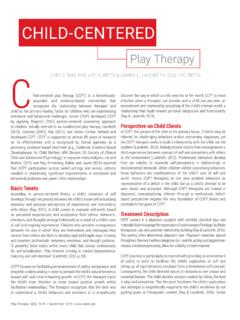Transcription of A Client-Centered Approach to Difficult Client Experiences*
1 A Client - centered Approach toDifficult Client Experiences* Margaret S. Warner, University/Chicago* State of the Art address presented at the 5th Congress of the WorldCouncil for Psychotherapy in Beijing China, October 20082In recent years, psychologists have become increasingly aware of the active rolethat clients play in their own healing (Bohart & Tallman, 1999). After an exhaustivereview of the research on therapeutic effectiveness, Bergin and Garfield (1994) is the Client more than the therapist who implements the change process. Ifthe Client does not absorb, utilize, and follow through on the facilitative efforts ofthe therapist, then nothing happens. Rather than argue over the question ofwhether therapy works we could address ourselves to the question of whetherthe Client works !
2 (p 825)Following this train of thought, Bohart and Tallman (1999) suggest that bothdirective and nondirective forms of therapy work because and promote change by helping clients mobilize, focus and use their ownresources for self therapists do is help clients use these resourcesmore (p. 14). Client - centered therapy is quite distinct in that it focuses almost exclusively onclients internally generated capacities for change. These include natural tendencies to--process experience--develop a cohesive sense of self--develop a personally meaningful sense of agency Carl Rogers (1957, 1961) proposes that, given these and other natural tendenciestoward actualization , a relationship that is genuine, empathic and prizing is both necessary and sufficient for producing therapeutic change.
3 A cluster of therapiesinfluenced by Carl Rogers, often referred to as the person- centered Approach , emphasize these sorts of capacities for self-directed change. Classically Client -centeredtherapists are the most strongly Client -directed of all of the person- centered therapies,emphasizing sensitive empathic responding to clients process as it develops3spontaneously within therapy. Experiential and process-experiential psychotherapistsoften take additional steps to teach or facilitate processing steps when processing seemsblocked. In this paper I will speak out of my experiences as a classically-oriented Client - centered therapist, though the key points being made apply to the whole family of person- centered therapies and in more indirect ways to the practice of psychotherapy in premise that clients are capable of self-directed change still seems wildlyimprobable to many psychotherapists.
4 How could a psychotherapy in which the therapistdoesn t offer new advice, new ways of looking at things, structured ways ofimplementing change in any systematic way result in positive outcomes? Yet, the mostrecent meta-analyses of therapeutic outcomes find Client - centered and experientialpsychotherapies to have equivalent outcomes to those of behavioral, cognitive-behavioraland psychodynamic approaches (Elliott, 2002; Elliott, Greenberg, & Lietaer 2004).These findings give powerful testimony to the existence of some sort of inherent humancapacities and tendencies toward clinicians assume that this demonstrated effectiveness of Client -centeredtherapy could not be expected to hold for more severely disturbed clients .
5 They assumethat clients in more extreme states of distress, who have more irrational thoughts or moreout of control behaviors must need stronger, more interpretive therapeutic clinical experience of Client - centered therapists has been the opposite of this. Wefind that levels of structure and guidance that may be used productively by clients in lesssevere distress are actively problematic for clients in the midst of more difficultexperiences. Even quite moderate interventions can: distance clients from the life experiences which have the most positive potential4for change bring intensified symptoms create relationship rupturesOn the other hand, we find that an empathic relationship combined with a veryclose empathic following of the most Difficult Client experiences allows for deep is true in the short run, as close empathic responding seems to lower clients senseof existential aloneness while it helps clients tolerate Difficult experiences with lessanxiety.
6 In the long run, the impact is much greater. An empathic relationship creates asafe space in which clients can stay connected to Difficult experiences. This allowsfundamental developmental tendencies to reconnect. In this presentation I am focusing onone particular human change capacity, a quality that Client - centered therapists call processing. I suggest that Client - centered therapy tends to strengthen processingcapacities in clients whose experience is most Difficult . As processing abilities becomestronger, clients are more able to interact in productive ways with other people, holding asense of their own experience and that of another person at the same time. Symptoms arelessened, experience becomes more integrated, a variety of life ventures become is Processing?
7 The concept of processing was elaborated by Carl Rogers and colleagues(1961) and further developed in the work of Eugene Gendlin (1964, 1968, 1995).Processing refers to the kinds of immediate experiential changes that human beingsnaturally go through as they make sense of life explore the concept of processing, let us look at the kinds of experientialchanges people typically go through as they try to make sense of experience. Someexperiences seem clear immediately. They make sense. The sun is coming up, it s timefor me to go to work; a family member is making other experiences bring a sense of challenge. Feelings, thoughts, experiences,bodily reactions come up that we don t expect. They don t immediately make sense tous.
8 Processing is what happens when an individual stays with an experience that istroublesome or not-yet-clear. This desire and capacity may seem obvious until you thinkabout it. How is it that human beings make sense of experience? What is happeningwhen people can t make sense of experience? How does this desire and this capacitydevelop? Let me give you a fairly simple, day-to-day example. A Client says:I was so excited to get my new job. It s just what I have always wanted. So Idon t understand why I feel so bad. I have just a tight feeling in my I have the image that I m very small and the building where I work ishuge. Like I ll be swallowed up and never get out. My stomachache just gotstronger when I said that.
9 I have the image of my father s face when he said, Why don t you ever study as hard as your sister? You are never going to amountto anything. So THAT s what it is. It feels like no matter how hard I try, I llfail. Somehow I ll never be as good a she , let s notice what this Client did:1. She notices an experience that is troublesome, but not yet clear to She pauses and attends to the totality of her sense of the She stays with experiences that emerge holding them in attention withoutstrongly judging or condemning them in She senses feelings relating to the experience, but she is not flooded withthese More experiences that are related to her concern come to her immediate feeling in her body that relates to her concern becomes morevivid to her.
10 She feels the pain in her stomach. Eugene Gendlin would call this a felt sense (1968).--images come to her that capture her whole sense of the situation--memories come that are related to her current experience of the situation6. Out of such new experiences the Client forms a new version of what ishappening and why and in the process relieves some amount of bodily a new version often offers the Client a clearer way forward, a sense ofwhat steps to take next. Gendlin (1964, 1968) emphasizes that making sense (or carryingforward into meaning) is a whole body process. There is no mind-body split. Note thatin this case, the Client s problem is not solved. But she has a new clearness as to what thefeeling is about for her.









